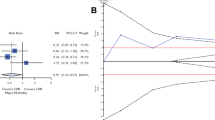Abstract
Background: The detection of small and often asymptomatic gallbladder calculi within the bile duct at intraoperative cholangiography (IOC) during laparoscopic cholecystectomy (LC) frequently poses a management dilemma. Therefore, we set out to compare the outcomes and costs of two management strategies for small stones that remain in the bile duct after LC—routine postoperative endoscopic retrograde cholangiopancreatography (ERCP) vs observation alone with ``on-demand'' ERCP.
Methods: We studied 70 patients with bile duct stones among 922 consecutive patients who underwent LC between 1990 and 1997. Data were collected prospectively. Bile duct calculi were detected in 70 of 705 patients (9.9%) with successful IOC. Of these, 44 patients had large calculi (≥5 mm in diameter) and were subjected to a laparoscopic common bile duct exploration. The remaining 26 patients had small calculi (<5 mm in diameter); four of them had undergone preoperative endoscopic sphincterotomy and duct clearance and were therefore excluded from analysis. Patients with small duct calculi were assigned, according to individual surgeon policy, to either routine postoperative ERCP (group A, n= 8) or observation (group B, n= 14). ERCP was reserved for those who become symptomatic. The two groups were comparable for age and sex distribution.
Results: No complications developed during the follow-up period in patients assigned to observation, although four became symptomatic and underwent ERCP. In group A, ERCP demonstrated a clear biliary tree in four patients and bile duct calculi in three patients; it failed in one patient. In group B, ERCP demonstrated a clear bile duct in one patient and bile duct calculi in two patients; it also failed in one patient. Endoscopic sphincterotomy and duct clearance were achieved in all patients with demonstrable bile duct calculi at ERCP. There was no morbidity or mortality associated with ERCP. The overall hospital stay was significantly longer in group A than in group B (median 5 vs 1.5 days; p= 0.011); however, the number of outpatient clinic visits was significantly greater in group b (median 3 vs 5.5, p= 0.011). The mean hospital costs, including the costs of hospital stay, readmissions, ERCP, and follow-up, were significantly greater in group A than in group B (mean £2669 vs £1508, p= 0.008).
Conclusion: A ``wait and see'' policy of observation alone for patients with small bile duct calculi detected at IOC during LC appears to be safe, and it is more cost-effective than routine postoperative ERCP. ERCP should be reserved for post-LC patients who become symptomatic.
Similar content being viewed by others
Author information
Authors and Affiliations
Additional information
Received: 20 May 1999/Accepted: 24 September 1999/Online publication: 28 September 2000
Rights and permissions
About this article
Cite this article
Ammori, B., Birbas, K., Davides, D. et al. Routine vs ``on demand'' postoperative ERCP for small bile duct calculi detected at intraoperative cholangiography. Surg Endosc 14, 1123–1126 (2000). https://doi.org/10.1007/s004640000146
Published:
Issue Date:
DOI: https://doi.org/10.1007/s004640000146




